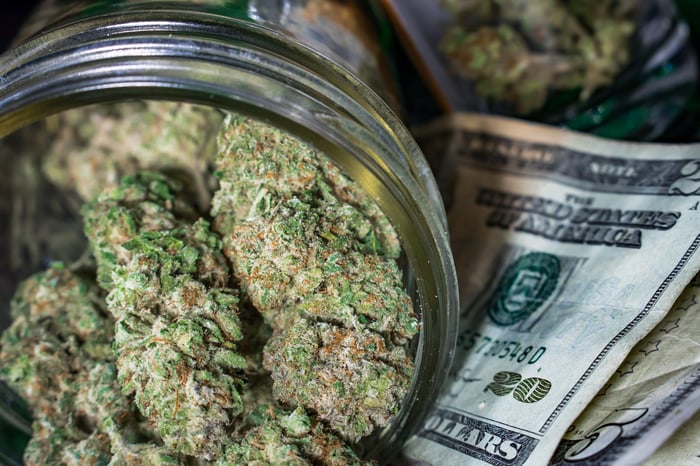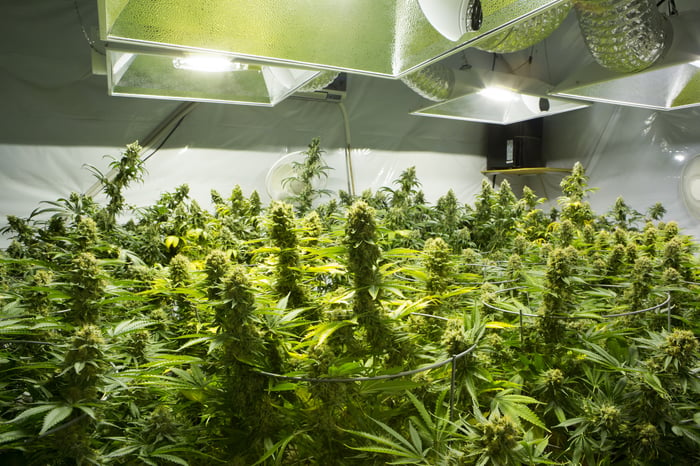The marijuana industry has come blazing out of the gates in 2019, with the first-ever tradable cannabis ETF, the Horizons Marijuana Life Sciences ETF, up 51% through the end of April. That not-too-shabby performance, which essentially triples the return of the S&P 500, signals how excited investors are about the long-term prospects for legal weed.
Then again, April was arguably the "worst" month of the year for pot stocks, with the Horizons Marijuana Life Sciences ETF declining by 1.6%. Of the 52 marijuana stocks I regularly track, nearly half of them (25) ended April lower.
But there's a big difference between simply ending the month lower and face-planting. The following five marijuana stocks all face-planted in April and lost at least 15% of their value. Let's take a closer look at what was going on with these popular pot stocks.

Image source: Getty Images.
Tilray: Down 22%
Last year, Tilray (TLRY) was briefly the story stock among all story stocks. Following its initial public offering on the Nasdaq in July, it rallied from a list price of $17 to hit an intraday high of $300 per share less than two months later. Of course, it's been a complete train wreck since, with shares losing another 22% in April to hit level that haven't been seen since August 2018.
The catalyst for the decline look to primarily be a carryover from its disappointing fourth-quarter earnings report in mid-March. Aside from simply missing Wall Street's revenue estimate -- Tilray generated $15.5 million in fourth-quarter sales, which was a tripling from the prior-year period -- the company threw a monkey wrench into its long-term strategy by announcing that it would be shifting its focus from Canada to Europe and the United States. Yes, the peak market potential for the EU and the U.S. are much higher than Canada, but to completely shift up the company's strategy so recently after the launch of recreational cannabis in Canada is a head-scratcher. It's left yours truly wondering if Tilray was completely outmaneuvered in Canada by the likes of Canopy Growth and Aurora Cannabis.
What's more, Tilray's strategy shift probably means pushing back recurring profit projections even further, as well as puts the company's domestic capacity expansion projects in limbo. Wall Street went from reasonable clarity to countless question marks with regard to Tilray, and its stock is rightly paying the price.

Image source: Getty Images.
Aleafia Health: Down 20%
Aleafia Health (ALEAF) has had a busy 2019, with the company closing a transformative acquisition of Emblem in mid-March, and announcing the addition of 50,000 kilograms of extraction capacity in April, which will be begin production sometime in the mid-third quarter. But it also had a miserable April, ending the month 20% lower from whence it began.
Although it would be easy to blame the company's fourth-quarter earnings report for this weakness, it was released well after most of the carnage. Rather, it looks to be the uncertainties surrounding the Aleafia Health-Emblem merger that are getting the best of shareholders for the time being.
On one hand, Aleafia Health will soon have 138,000 kilos of annual peak production capacity (good enough for the seventh-highest peak output in Canada), to go along with its 50,000 kilos of extraction capacity. And since Emblem also ran medical clinics to go along with its vertically integrated cannabis operations, the newly combined company has the potential to keep an estimated 60,000 patients loyal to their in-house brands.
On the other hand, Aleafia Health had just 63.2 million Canadian dollars at years' end, on a pro forma basis, and that doesn't seem like nearly enough of a cash buffer to complete its numerous projects, handle brand building, marketing, and other costs. This suggests dilutive share offerings are a possibility.
The other issue is Aleafia's production is coming to market later than many of its larger peers, and it's unclear how effective an under-the-radar producer will be in gobbling up recreational and medical market share. For what it's worth, I'm intrigued by Aleafia Health's valuation here, but also understand why investors would be skeptical.

Image source: Getty Images.
Aphria: Down 19%
Another one of the most popular pot stocks, Aphria (APHA), found the sledding in April tough as well. Despite slotting in as the third-largest grower in Canada, with 255,000 kilos of peak annual output when at full capacity, third-quarter earnings results absolutely doomed the company.
Although Aphria recorded CA$73.6 million in revenue, which was a better than 615% improvement from the prior-year period, this figure proved to be nothing more than lipstick on a pig. Rather, the company's acquisition of distributor CC Pharma was responsible for most of the revenue recognized during the quarter, with cannabis sales retracing. In fact, sequential kilos sold fell from 3,409 in the second quarter to only 2,637 in the third quarter. Like most pot stocks, Aphria is contending with supply chain issues, and its operating results reflect this.
What was arguably worse was the fact that Aphria took a CA$50 million writedown on the carrying value of its Latin American assets, which were acquired for CA$195 million. For those who may not recall, Aphria faced a scathing short-seller report in early December that claimed it grossly overpaid for these Latin American assets. An independent review found this not to be the case, but just a few months later an impairment test on these assets requested from the Ontario Securities Commission resulted in a writedown that pushed Aphria to a CA$108.2 million net loss in Q3 2019.
Put in another context, Aphria was already facing a crisis of confidence with management, and despite partially overhauling its management team, this writedown doesn't help it in its quest to regain investors' trust.

Image source: Getty Images.
VIVO Cannabis: Down 16%
On the surface, VIVO Cannabis (VVCIF) looks as if it has its ducks in a row. With two primary grow sites in Napanee, Ontario and Hope, British Columbia, below-average growing costs, and Canada waving the green flag on recreational pot, you'd think everything would be going its way. But its 16% loss in April shows otherwise.
VIVO Cannabis did report its fourth-quarter and full-year results on the final day of the month, and they certainly weren't anything to write home about. With operations just now really getting off the ground, gross revenue and net revenue rose to CA$13.3 million and CA$9.7 million, respectively, for 2018, up from only CA$1.2 million and CA$0.9 million in 2017. But despite this rise in sales, adjusted EBITDA (earnings before interest, taxes, depreciation, and amortization) worsened to negative CA$17.7 million from negative CA$11.1 million in 2017.
But the company's earnings results only tell half the story. The real problem is that, despite low growing costs, it's only expected to have annualized production capacity of 15,000 kilos by early 2020. With such limited production capacity, VIVO is quickly becoming an afterthought in an industry where capacity expansion was the name of the game in 2018. Even with the company discussing possible partnerships or capacity expansion opportunities, it might be too far behind its peers make a difference as an independent operator, and could be too small to really get on a larger growers' radar.

Image source: Getty Images.
Medical Marijuana, Inc.: Down 15%
Last, but not least, hemp oil and cannabidiol products manufacturer and distributor Medical Marijuana (MJNA -20.00%) once again found its way to a list of the worst-performing pot stocks after shedding 15% in April.
Part of the reason for the decline may have to do with the release of Medical Marijuana's fourth-quarter and full-year results. Despite racking up almost $60 million in sales, and registering a gross profit margin of 67.4%, it still lost around $8 million on an operating basis. Since its inception, Medical Marijuana has consistently lost money on an operating basis, and investors might be tired of waiting around for the company's bottom line to improve.
Another factor to consider is that Medical Marijuana's investment in Axim Biotechnologies has shrunk considerably over the past two years. Even though it's still up overall on its 38% equity stake in Axim, the share price for Axim has tumbled from north of $20 in early 2017 to a measly $1.25 this past Tuesday, April 30. As a result, Medical Marijuana made a nearly $190 million adjustment on the value of its investments last year, which ultimately ballooned its net loss in 2018 to $202.6 million.
It's also worth noting that nearly half of Medical Marijuana's total assets are tied up in goodwill, which is very high, even among acquisition-hungry pot stocks. It demonstrates just how much hope is built into this company's valuation, and might help better explain why investors headed for the exit last month.





